Is Your Brazil Factory Struggling with Automation in Busy Meatpacking and Pharma Zones? Try a Pallet Changing Machine
Your factory in Brazil is buzzing. Orders are flowing in for your meat or pharmaceutical products. The production lines are running at full speed. But there's a bottleneck. At the point where goods move from production to warehouse, or from warehouse to truck, everything slows down. You see teams of workers manually unstacking and restacking pallets, a slow and labor-intensive process. This manual handling creates risks—product damage, contamination, and worker injury. You know this inefficiency is costing you money and holding back your growth, but finding a single automation solution that is both hygienic and fast seems like an impossible challenge.
Yes, a pallet changing machine, also known as a pallet inverter, is a powerful and effective solution for automation struggles in Brazil's demanding meatpacking and pharmaceutical environments. This equipment directly solves the core problems of these industries. It automates the transfer of goods from one pallet to another, such as from a wooden shipping pallet to a sanitized in-house plastic pallet. This single step enhances hygiene, eliminates the high costs and risks of manual labor, prevents product damage, and dramatically speeds up your entire logistics workflow.
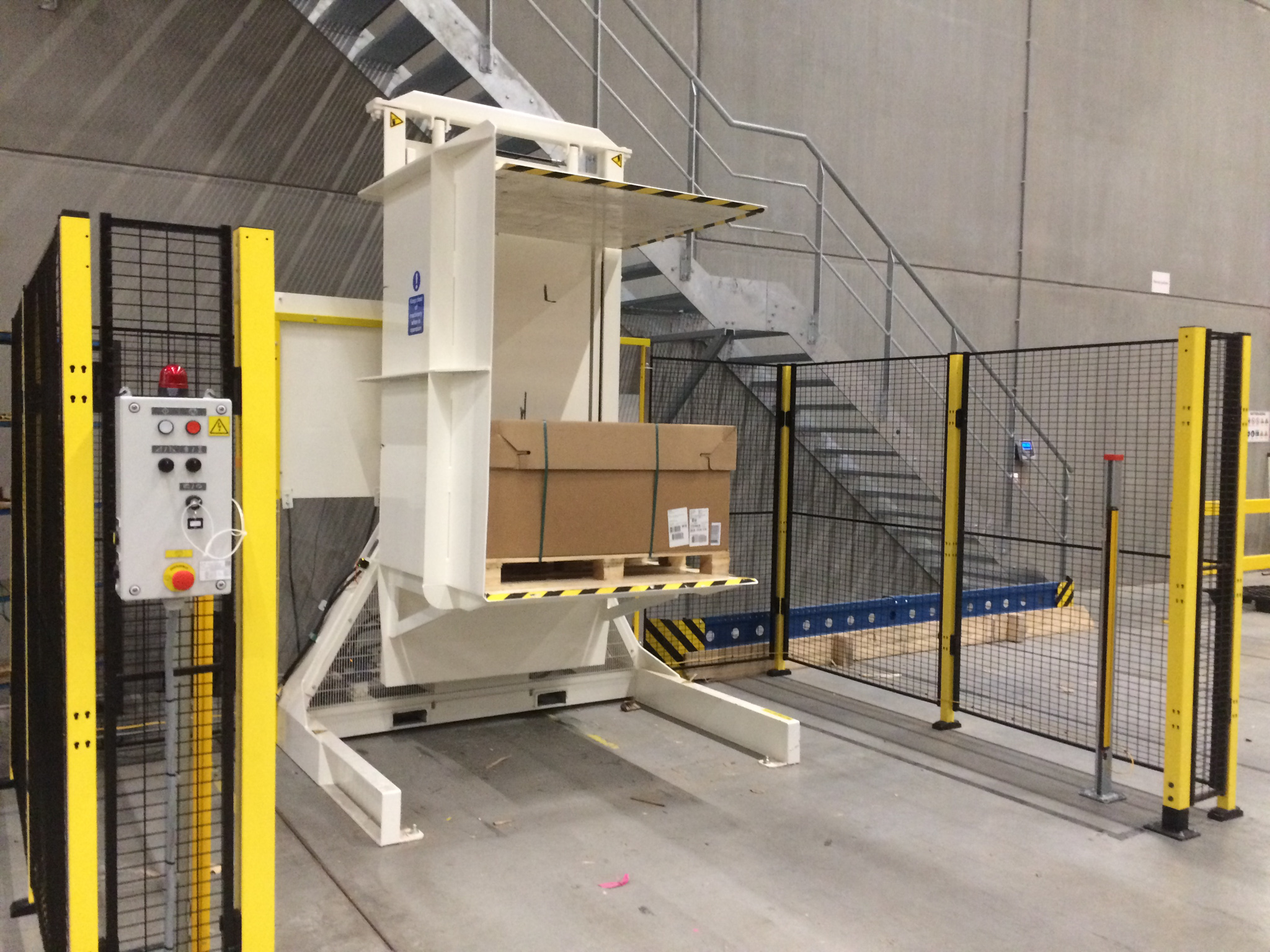
I understand that investing in new machinery is a big decision. As an engineer who has spent his life on the factory floor, I know you need more than just a sales pitch. You need to understand the mechanics, the return on investment, and how a machine will solve your specific, real-world problems. You are likely asking yourself if this machine can truly handle your unique products and if it is worth the cost. Let's break down these questions. We will look at the precise ways a pallet changer can transform your operation from a source of stress into a streamlined, efficient, and profitable part of your business.
How can a pallet changer solve hygiene and contamination issues in food processing?
You run a clean facility. You follow all the regulations for your meatpacking operations in Brazil. But there's a weak link you might be overlooking: the wooden pallet. These pallets arrive from outside your controlled environment, carrying dust, moisture, and potentially harmful microbes. They are a gateway for contaminants. This creates a constant risk of a product recall, a damaged reputation, or failing a critical audit. The solution is to create a closed-loop system with clean, in-house pallets, but how do you make that transition without stopping your entire line?
A pallet changer is the gatekeeper that solves this hygiene problem. It works by automating the transfer of your products from an external "dirty" pallet to an internal, sanitized pallet without manual intervention. This process occurs at the entry point to your sensitive production or storage area. It ensures that the contaminants often found on wood pallets—like bacteria, mold, and splinters—never cross the threshold into your clean zone, protecting your product integrity and brand reputation.
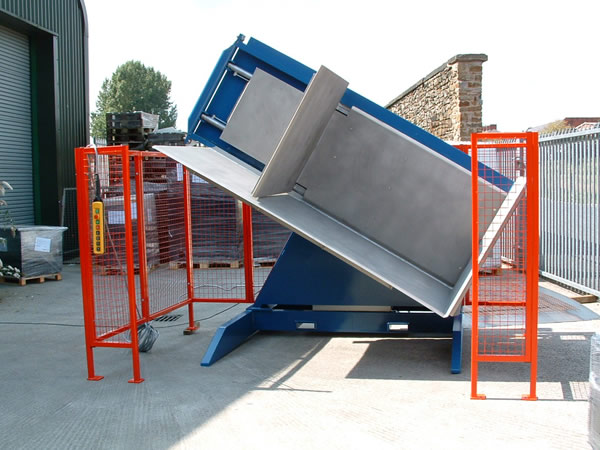
Dive Deeper: Establishing a Hygienic Barrier
In my years of designing and building packaging solutions, I've seen firsthand how something as simple as a pallet can undermine millions of dollars in hygiene investments. The problem is fundamental to the material.
The Hidden Dangers of Wood Pallets
Wooden pallets are a standard for shipping, but they are a nightmare for hygiene-sensitive industries like meatpacking and pharmaceuticals.
- Porosity: Wood is like a sponge. It absorbs moisture, which creates a perfect breeding ground for bacteria and mold. In a humid climate like many parts of Brazil, this problem is even worse.
- Contaminants: Splinters, dust, and nails from wooden pallets can easily find their way into your product or processing area, creating physical contamination hazards.
- Pests: Wood can harbor insects and other pests, which is an immediate red flag for any food safety inspector.
- Sanitation Difficulty: You can't effectively wash and sanitize a wooden pallet. The porous surface makes it impossible to ensure it's truly clean.
The In-House Pallet Program: Your First Line of Defense
The best practice is to implement an "in-house pallet" program. This means you use one type of pallet for all external shipping and receiving (usually wood, because it's cheap and standard) and a completely separate set of pallets for internal use. These internal pallets are typically made of non-porous materials like plastic or aluminum. They are easy to clean, durable, and don't carry the risks of wood.
But this program only works if you have a reliable way to transfer goods between the two pallet types. Doing this manually is slow and re-introduces the risk of contamination if a worker drops a box on the floor.
The Pallet Changer as a Process Enforcer
This is where the pallet changer becomes more than just a machine; it becomes a critical control point. It automates and enforces your hygiene protocol. The process is simple and secure. A forklift brings the incoming load on a wooden pallet to the machine. The machine clamps the load, rotates it, and allows the operator to easily remove the wooden pallet. Then, a clean, sanitized plastic pallet is placed on top, and the machine rotates the load back. The entire transfer happens within the machine's controlled space.
Let's compare the two methods directly:
| Feature | Manual Pallet Exchange | Automated Pallet Changer |
|---|---|---|
| Contamination Risk | High. Goods may be placed on the floor. Multiple hands touch the product. | Minimal. The product is secured within the machine. No floor or direct hand contact. |
| Foreign Object Risk | High. Wood splinters and dust are easily dislodged during manual handling. | Eliminated. The wooden pallet is removed before entering the clean area. |
| Process Consistency | Low. Depends on the diligence of individual workers. | High. The same clean, repeatable process every time. |
| Audit Trail | Difficult. Hard to prove that protocol was followed every time. | Easy. The process is standardized and can be logged, aiding in compliance. |
By installing a pallet changer, you are building a physical wall against contamination. You are not just buying a piece of equipment; you are investing in process integrity and peace of mind.
What are the real costs of manual pallet handling in high-volume industries?
You look at your budget and see the wages for the workers on your loading dock. That seems like the main cost of manual pallet handling. But the true cost is much higher and mostly hidden. It's in the medical bills and lost time from a worker's back injury. It's in the value of a full pallet of pharmaceuticals crushed when it was dropped during a manual transfer. It's in the high employee turnover because nobody wants to do such a physically demanding job. These invisible costs drain your profits every single day.
The real cost of manual pallet handling extends far beyond payroll. It encompasses significant expenses from workplace injuries and compensation claims, product losses due to damage, production delays caused by bottlenecks, and the constant cycle of hiring and training new employees. A pallet changing machine directly targets these hidden costs, converting them from unpredictable expenses into predictable, efficient, and safe operations.
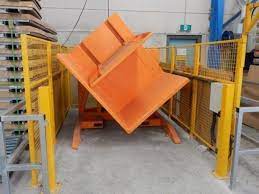
Dive Deeper: Uncovering the Hidden Financial Drains
When I started my own factory, I had to become obsessed with costs. I learned that the most dangerous expenses are the ones you don't track properly. Manual pallet handling is a perfect example. Let’s put some numbers to it.
The Crippling Cost of Worker Injuries
Manually de-stacking and re-stacking a pallet is one of the most ergonomically hazardous jobs in a factory. A single pallet can weigh over 1,000 kg. Workers are constantly bending, lifting, and twisting. This leads to a high incidence of musculoskeletal injuries, especially to the back and shoulders.
In Brazil, the costs associated with a workplace injury are substantial. You have:
- Direct Costs: Medical treatment, compensation payments, and legal fees.
- Indirect Costs: Lost productivity from the injured worker, time spent by supervisors on incident reports, potential production slowdowns, and the negative impact on team morale. A single serious injury can easily cost tens of thousands of dollars, far exceeding the annual wages of the employee.
The Financial Impact of Product Damage
Imagine a pallet of temperature-sensitive pharmaceuticals. During a manual transfer, a worker loses their grip, and a few cases fall and break. The direct loss is the cost of those goods. But the indirect loss is greater. You may have to scrap the entire pallet due to contamination risk or temperature deviation. A pallet of meat products dropped on a non-sanitized floor is a total loss. With high-value goods, a damage rate of even 1% can translate into huge financial losses over a year. An automated pallet changer handles the entire load as a single, secure block, reducing the damage rate to virtually zero.
The Bottleneck Effect and Labor Inefficiency
Let’s analyze the process. It might take two workers 15 minutes to manually transfer one pallet load. That’s a maximum of 4 pallets per hour, per team. A pallet changer, operated by one person, can do the same job in 90 seconds. That’s 40 pallets per hour. The manual process is not just slow; it’s a bottleneck that restricts the flow of your entire supply chain. It forces trucks to wait, can lead to overtime pay, and may even cause you to miss shipping deadlines.
Here’s a simple cost comparison:
| Cost Category | Manual Handling (2 Workers) | Automated Pallet Changer (1 Operator) |
|---|---|---|
| Time per Pallet | 15 minutes | 1.5 minutes |
| Pallets per Hour | ~4 | ~40 |
| Injury Risk Cost | High and Unpredictable | Negligible |
| Product Damage Rate | Can be 1-3% | Less than 0.1% |
| Labor Cost per Pallet | High | Low (10x reduction in man-hours) |
Investing in a pallet changer is not an expense. It is a direct strategy to eliminate these unpredictable and significant hidden costs. The return on investment is often realized in less than 12-18 months, simply from the savings on labor, damage, and injury prevention.
How does a pallet changer increase throughput in a busy warehouse?
Your production lines are highly optimized, churning out products at an impressive rate. But then the finished goods reach the end of the line, and everything hits a wall. A pile-up of pallets waits to be moved, wrapped, or loaded. This chokepoint at your warehouse or loading dock is frustrating. It means your expensive production machinery is being held back by a slow, manual process. Trucks are waiting, drivers are getting impatient, and your operational efficiency is dropping.
A pallet changer dramatically increases warehouse throughput by transforming a slow, multi-step manual task into a single, rapid automated cycle. By replacing a 15-minute manual restacking process with a 90-second machine cycle, it breaks the bottleneck between production and logistics. This allows for a continuous, smooth flow of goods from the production line to the delivery truck, maximizing the capacity of your entire facility.
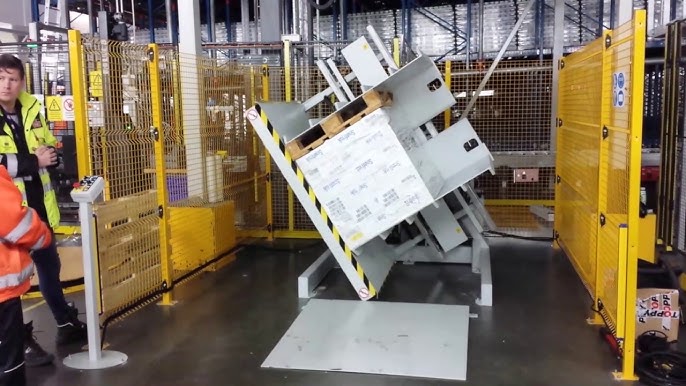
Dive Deeper: From Bottleneck to Free-Flowing Channel
I learned a crucial lesson early in my career: a chain is only as strong as its weakest link. In many factories, that weak link is the point where pallets need to be handled. You can have the fastest processing equipment in the world, but if you can't get the product out the door just as fast, you haven't gained anything.
A Head-to-Head Cycle Time Analysis
The numbers are the clearest way to see the impact.
- Manual Process:
- Two workers approach the pallet.
- They remove any stretch wrap.
- They lift boxes one by one, or in small stacks, and place them on a new pallet.
- This process is physically tiring, so the pace slows down over a shift.
- Total Time: 10 to 20 minutes, depending on the load's weight, height, and stability.
- Automated Pallet Changer Process:
- One forklift operator places the entire pallet into the machine.
- The operator presses a button on the control panel.
- The machine clamps the load, rotates, and opens to allow the old pallet to be removed.
- The operator inserts the new pallet and presses the button again. The machine rotates back.
- The forklift removes the finished load.
- Total Time: 60 to 90 seconds.
The difference is not small. It is a 10x to 15x improvement in speed. This isn't just a marginal gain; it's a transformation of your warehouse's capacity. A team that struggled to handle 30-40 pallets in a day can now process 30-40 pallets in an hour.
Strategic Placement for Maximum Impact
The beauty of this solution is its versatility in placement.
- At Receiving: Place the pallet changer at your inbound dock. All incoming goods on wooden pallets are immediately transferred to your clean, internal plastic pallets before they even enter your main warehouse. This streamlines put-away and improves hygiene from the very start.
- At Shipping: Place it at the outbound dock. Your products can be stored on high-quality internal pallets. When an order is ready to ship, you can quickly transfer it to a cheaper, one-way shipping pallet or a specific pallet type required by your customer (like a CHEP or PBR pallet, common in Brazil).
- End-of-Line Integration: For ultimate efficiency, the pallet changer can be integrated directly with conveyors from your production line, creating a fully automated, touchless process from production to warehousing.
I remember a client in the Brazilian meatpacking industry who faced this exact problem. Their blast freezers were efficient, but the frozen blocks of meat would pile up at the exit. The cold environment made manual handling even slower and more difficult. We installed a stainless steel pallet inverter designed for low temperatures. It was a game-changer. They could now clear the freezer output in real-time. The bottleneck vanished, and their overall plant throughput increased by over 20% without touching the production machinery.
Can a single machine handle different load types and sizes in pharma and food?
Your factory is complex. One hour you are palletizing small, fragile vials of medicine, and the next you are handling heavy, bulky sacks of raw ingredients. The idea of a single automation solution seems unrealistic. You believe you need the flexibility of manual labor to handle such variety, or you would need to buy several different machines, which is too expensive. This thinking keeps you stuck with an inefficient, high-cost process because you fear a machine can't be as adaptable as a person.
Yes, a single, modern pallet changing machine is designed with the versatility to handle a wide range of load types and sizes found in the pharmaceutical and food industries. Through advanced engineering features like adjustable clamping pressure, a large opening range for different pallet heights, and multiple operating modes, one machine can be precisely configured to safely manage everything from delicate, boxed goods to heavy, stable sacks or drums.
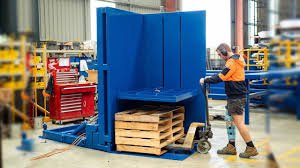
Dive Deeper: Engineering for Adaptability
As an engineer, this is the part I find most exciting. Building a powerful machine is one thing; building a smart and adaptable one is the real challenge. The fear that a machine is too rigid for a varied production environment is based on older technology. Today's pallet changers are built for flexibility. Here are the key features that make this possible.
The Three Pillars of Versatility
-
Adjustable Clamping Pressure: This is the most critical feature for handling different products. The machine has two platforms that clamp the load from the top and bottom to secure it during rotation. The pressure exerted by these clamps can be precisely controlled.
- For delicate loads: Like boxes of glass vials or sensitive electronics, you can set the pressure very low—just enough to hold the load without crushing it.
- For heavy, stable loads: Like bags of flour or cement, you can set the pressure high to ensure the load is completely stable and does not shift during the 180-degree inversion.
This adjustment is typically done via a simple gauge or a digital HMI screen.
-
Variable Jaw Opening: Products come on pallets of all heights. A pallet of bottled water is much taller than a pallet of small, flat boxes. A modern pallet inverter has a wide opening range (e.g., from 600mm up to 2400mm) to accommodate this variety. The top clamp can be moved up or down to fit the specific height of the load you are handling, ensuring a perfect fit every time.
-
Different Operating Modes: Not all loads should be turned completely upside down. That's why we offer different types of machines.
- 180° Inverter: This is the standard and fastest model. It clamps the load and rotates it a full 180 degrees. It's perfect for most boxed goods, sacks, cans, and other stable products.
- 90° Tilter (Pallet Changer): For loads that cannot be inverted, like open-top pails, buckets, or very unstable products, this machine is the solution. It clamps the load and tilts it back 90 degrees. This allows the old pallet to slide off and a new one to be inserted. The process is gentler and avoids inversion completely.
Customization for Your Exact Needs
Beyond these standard features, we at SHJLPACK often customize machines. We are not just resellers; we are the factory. This means we can build a solution for your specific challenge.
- Material: For meatpacking or dairy, we build the machine from 304 stainless steel for wash-down compliance.
- Controls: We can program the PLC with pre-set recipes. An operator can simply select "Product A" or "Product B" on a touchscreen, and the machine automatically adjusts the clamping pressure and other settings.
- Loading: We can provide models that are loaded by forklift or models that have a low-profile base and can be loaded with a simple pallet jack.
This table shows how different features apply to specific loads:
| Load Type | Recommended Feature/Model | Why it Works |
|---|---|---|
| Boxes of Vials (Pharma) | 90° Tilter with Low Clamping Pressure | Gentle handling protects fragile contents and avoids inverting them. |
| Sacks of Ingredients (Food) | 180° Inverter with High Clamping Pressure | Securely grips and quickly inverts heavy, stable loads. |
| Drums or Barrels | 180° Inverter with a "V" Block Cradle | The specialized cradle holds the round shape securely during rotation. |
| Frozen Meat Blocks | Stainless Steel 180° Inverter | Built to withstand low temperatures and corrosive cleaning agents. |
You do not need to settle for an inefficient manual process. A single, well-designed pallet changer can provide the flexibility you need with all the benefits of automation.
Conclusion
In short, a pallet changer is a strategic investment that boosts hygiene, safety, and speed in any busy Brazilian factory, paying for itself through efficiency gains.




